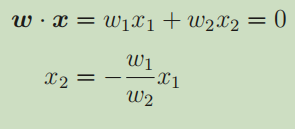-
-(theta[0] + theta[1] * x1 + theta[3] * x1 ** 2) / theta[2]
? ? ? ? 理解代码的时候有点好奇为什么每个直线或者曲线的分母都是??theta[2] 。故将公式对比起来分析分析。
????????
???????? ?
?
???????? ?
?
? ? ? ? 可以看到,每个结果的直线或曲线都是 x2 分母自然也是 θ2 。所以 x2 是我们设定的求解过程的未知量 ,也是分类决策边界的结果。
- 开始不知道这 plot() 函数 x y 的位置写了什么东西。输出了各个参数后才明白是什么意思。?
plt.plot(train_z[train_y == 1, 0], train_z[train_y == 1, 1], 'o')
plt.plot(train_z[train_y == 0, 0], train_z[train_y == 0, 1], 'x')

????????可以看到,train_y 是标签 1 或 0 的数组 。令 train_y == 1 判断可以得到 True 和 False 判断结果的数组。结合右边的 0 是列。故?train_y == 1, 0 放入 train_z 可以得到标签是 1 列为 0 的坐标 x。同理,右边的?train_z[train_y == 1, 1] 也是标签为 1 列为 1 即坐标 y 。
????????另一行按同样思路分析即可。
-
# 分类函数 def classify(x): return (f(x) >= 0.5).astype(np.int) for _ in range(epoch): theta = theta - ETA * np.dot(f(X) - train_y, X) # 计算现在的精度 result = classify(X) == train_y accuracy = len(result[result == True]) / len(result) accuracies.append(accuracy)
????????classify(X) ?== train_y。 分类函数返回X概率大于或小于0.5的 0 或 1 值,与 train_y 的标签进行判断,将判断结果记录在 result 。
???????? ?
?
? ? ? ? accuracy。 分子是正确归类的个数,分母是总个数,相比计算精度。
? ? ? ? 最后将本次循环精度记录在 accuracies 数组里。
# 实现代码
import numpy as np
import matplotlib.pyplot as plt
# 读入训练数据
train = np.loadtxt('data3.csv', delimiter=',', skiprows=1)
train_x = train[:,0:2]
train_y = train[:,2]
# 参数初始化
theta = np.random.rand(4)
# 标准化
mu = train_x.mean(axis=0)
sigma = train_x.std(axis=0)
def standardize(x):
return (x - mu) / sigma
train_z = standardize(train_x)
# 增加 x0 和 x3
def to_matrix(x):
x0 = np.ones([x.shape[0], 1])
x3 = x[:,0,np.newaxis] ** 2
return np.hstack([x0, x, x3])
X = to_matrix(train_z)
# sigmoid 函数
def f(x):
return 1 / (1 + np.exp(-np.dot(x, theta)))
# 分类函数
def classify(x):
return (f(x) >= 0.5).astype(np.int)
# 学习率
ETA = 1e-3
# 重复次数
epoch = 5000
# 更新次数
count = 0
# 重复学习
for _ in range(epoch):
theta = theta - ETA * np.dot(f(X) - train_y, X)
# 日志输出
count += 1
print('第 {} 次 : theta = {}'.format(count, theta))
# 绘图确认
x1 = np.linspace(-2, 2, 100)
x2 = -(theta[0] + theta[1] * x1 + theta[3] * x1 ** 2) / theta[2]
plt.plot(train_z[train_y == 1, 0], train_z[train_y == 1, 1], 'o')
plt.plot(train_z[train_y == 0, 0], train_z[train_y == 0, 1], 'x')
plt.plot(x1, x2, linestyle='dashed')
plt.show()
# 参数初始化
theta = np.random.rand(4)
# 精度的历史记录
accuracies = []
# 重复学习
for _ in range(epoch):
theta = theta - ETA * np.dot(f(X) - train_y, X)
# 计算现在的精度
result = classify(X) == train_y
accuracy = len(result[result == True]) / len(result)
accuracies.append(accuracy)
#将精度画成图
x= np.arange(len(accuracies))
plt.plot(x,accuracies)
plt.show()